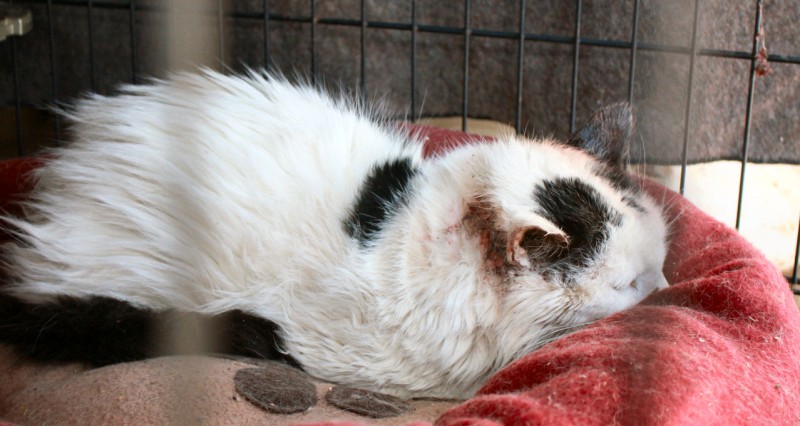
A shy, scraggly, dirty cat began hanging around my house some years ago. He wouldn't come near me and ran when I approached but he needed a lot of care, so I started putting food and water out for him every day. He liked to sleep in the carport on a pile of old blankets. From a window, I could see him out there. Sometimes when he was sleeping very deeply, I could walk past him quietly and get a better look at him.
One day I noticed blood on his head. From that day on, I watched more carefully. Finally I got a clear look at his head and saw that his ears were raw and bloody. With help from my housemate, Dave, I set out to trap him so he could be taken to the vet.
This cat was too wary of a live trap, so one night we lured him into a large dog crate using food. I had set up a rope to pull the door shut from about twenty feet away, and Dave was hiding out of sight nearby to quickly lock the crate door once the cat was inside. Then we moved the crate into the back of my minivan to take him to the vet in the morning.
The vet required a name for the animal. Given how angry he was at being trapped, Dave suggested the name "Rampy" (as in "ramp and rage"). The vet neutered Rampy, applied flea meds and examined his ears. They were overrun with ear mites, so the vet cleaned them up and treated them.
We brought Rampy home in the dog crate. While he was still groggy from the anesthetic, I slipped a litter box, cat bed, food and water bowls into the crate where he would spend the next few days. Dave and I collaborated to apply a healing salve to the backs of Rampy's ears twice a day. We used a 1"x2" stick of lumber pushed through the metal bars of the crate to force Rampy against the side, and an artist's sable paint brush to apply the salve.
Meanwhile we prepared the quarantine pen in the corner of my living room for Rampy to have more room to move around during his recovery. He would need to spend another week or so in the quarantine cage so as not to require re-trapping to go back to the vet for a second round of ear treatment. A cat carrier with its door tied open was placed in the cage for Rampy to use as a hide-away and sleeping area.
During his quarantine time, Rampy got to meet my other cats. All of them were curious about this newcomer. The curiosity was mutual. As Rampy's male hormones declined, he gentled down enough that I could refill his food and water bowls and clean his litter box without being attacked.
After his second visit to the vet, Rampy became less and less anxious when I approached his quarters. He started spending more time interacting with the other cats. He also spent a good deal of time looking out the window, as if he was longing to get back outside.
One day I decided to open the cage door and allow Rampy to roam the house. He went straight to the front door and cried to be let out. I had to choose whether to let him go or keep trying to turn him into house cat. Ultimately I decided to put the big dog crate on the front porch with a bed and his food/water inside. I left him there overnight and let him out in the morning, hoping he would come back when he was hungry or wanted a safe place to sleep.
Rampy kept returning for food every day. He often napped on top of the dog crate. Dave and I would sit on the porch while Rampy was eating, to help him lose his fear of us. At first he would attack our feet after we set his food dish down, but within a few weeks we were able to stroke his back while he was eating. Then one day he decided to jump into Dave's lap! It was so gratifying to see this cat learn to trust a human!
About five months after he was first captured, Rampy accepted my invitation to walk into the house. He spent about half an hour looking around and interacting with the other cats, then asked to go back out.
From then on, Rampy would spend increasing amounts of time indoors. He would occasionally spend the night inside. He developed a fascination with my pet rabbit, Timothy, and would spend hours playing with him. Sometimes he even slept on my bed in a pile with other cats. But he never learned to use a litter box consistently, and thus could not be a full-time house cat.
After some years, Rampy's health declined and he eventually disappeared, never to return. He was such a gentle soul. We will never forget or regret the time we had with him.
AVA, MO